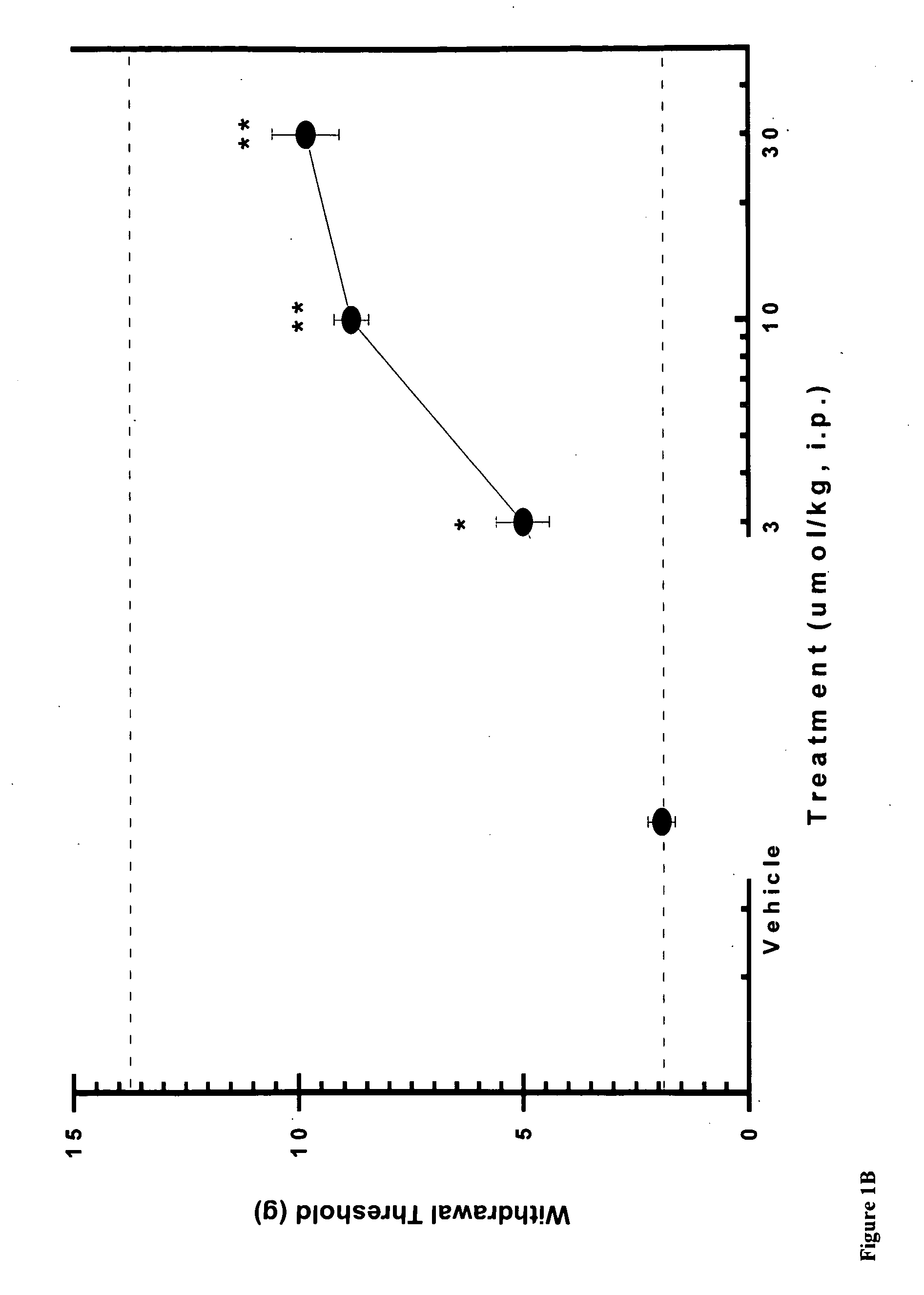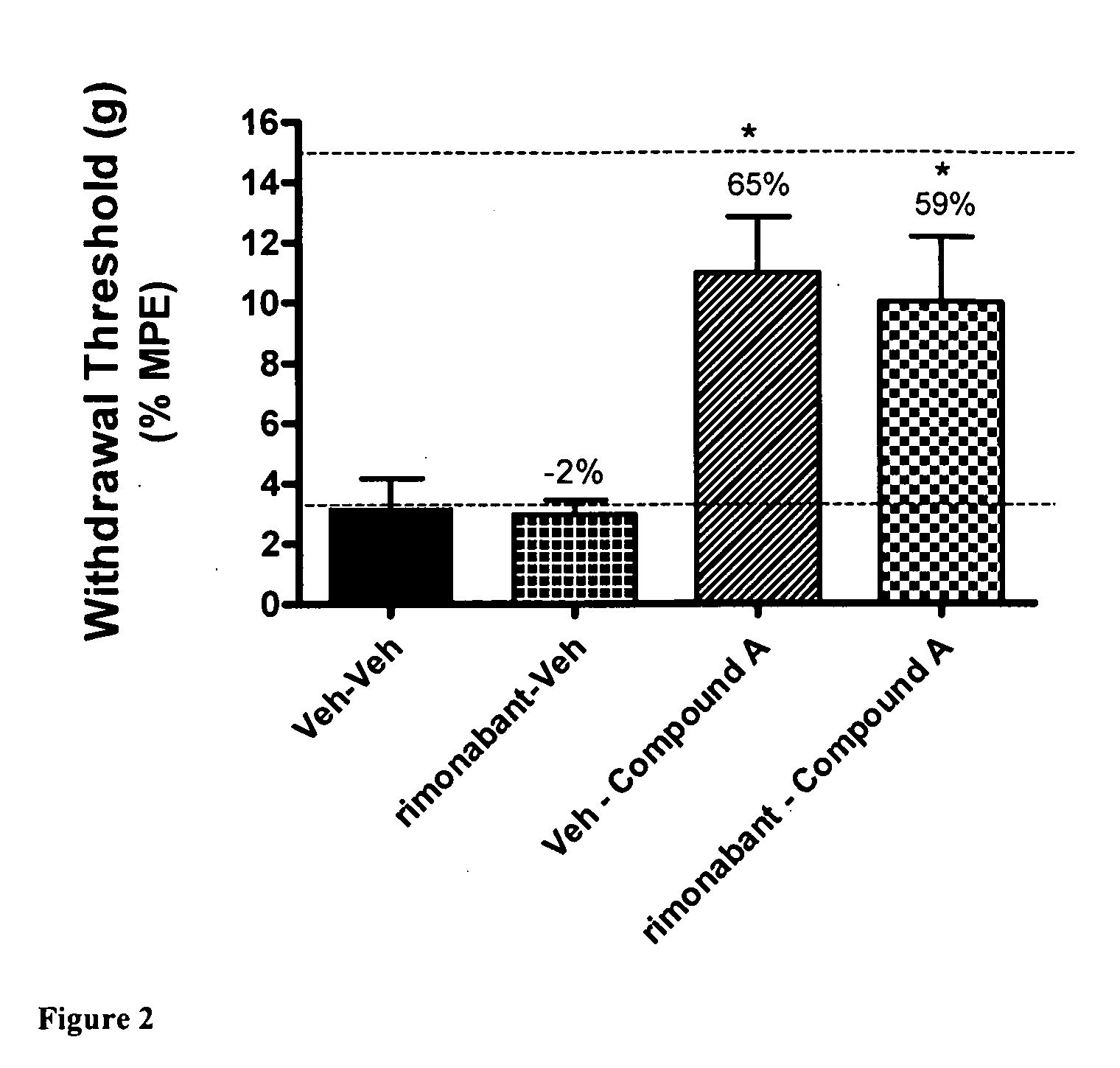Combination therapy for reducing side effects using cannabinoid receptor ligands
a cannabinoid receptor and combination therapy technology, applied in the direction of drug compositions, immunological disorders, metabolism disorders, etc., can solve the problems of poor executive function and learning impairment, a number of undesirable physiological and behavioral effects, and short-term memory loss
- Summary
- Abstract
- Description
- Claims
- Application Information
AI Technical Summary
Problems solved by technology
Method used
Image
Examples
example 1
CB2 Selective Agonists Effective in Skin Incision Model
[0079]Using the skin incisional model of postoperative pain, the effects of compound A, CB2 agonist (Z)-N-(5-tert-butyl-3-butylthiazol-2(3H)-ylidene)-5-chloro-2-methoxybenzamide, on allodynia was assessed two hours after surgery. FIG. 1A shows that the withdrawal threshold for the incisional paw recovered upon i.p. administration of 10 and 30 μmol / kg of CB2 agonist A. FIG. 1B shows similar results with compound B, CB2 agonist (Z)-N-(3-(2-methoxyethyl)-4,5-dimethylthiazol-2(3H)-ylidene)-2,2,3,3-tetramethylcyclopropanecarboxamide, re-establishing withdrawal threshold at 10 and 30 μmol / kg i.p. These results indicate the potent effects obtained with CB2 agonists in this rat pain model.
example 2
Effects of CB2 Agonist and CB1 Antagonist on Analgesia in Skin Incision Model
[0080]Using the skin incisional model of postoperative pain, the effects of CB2 agonist A were evaluated after the administration of vehicle or the CB1 antagonist rimonabant. This effect was compared with the administration of vehicle after the administration of vehicle or the CB1 antagonist rimonabant. A first dose, consisting of CB1 antagonist rimonabant (30 μmol / kg i.p.) or a vehicle (5% DMSO / PEG), was administered 15 minutes before a second dose, consisting of administration of CB2 agonist A (30 μmol / kg i.p.) or vehicle. Allodynia testing was conducted 30 minutes after administration of the second dose, either CB2 agonist A or vehicle. FIG. 2 shows that either the two administrations of vehicle or the administration of vehicle 15 minutes after the CB1 antagonist rimonabant did not ameliorate the tactile allodynia in the operated rats. FIG. 2 also shows that CB2 agonist A administered after vehicle, or t...
example 3
Effects of CB1 Antagonist and CB2 Agonist B on Spontaneous Locomotor Activity
[0081]FIG. 3 shows that CB2 agonist B significantly reduces spontaneous locomotor activity when administered to rats at 30 and 45 μmol / kg i.p. (solid bars). This reduction in locomotor activity was eliminated when 30 μmol / kg i.p CB1 antagonist rimonabant was administered 15 minutes before the administration of CB2 agonist B. All tests were conducted 30 minutes after the administration of CB2 agonist B. These results indicate that a higher dose of the CB2 agonist B did not reduce the rats' spontaneous activity when administered with a CB1 antagonist. These effects also indicate that the reduction in locomotor activity by CB2 agonist B results from its residual activation of the CB1 receptor. Accordingly, co-dosing CB2 agonist B with the CB1 antagonist rimonabant significantly reduced the adverse effects.
PUM
| Property | Measurement | Unit |
|---|---|---|
| total volume | aaaaa | aaaaa |
| withdrawal threshold | aaaaa | aaaaa |
| blood pressure | aaaaa | aaaaa |
Abstract
Description
Claims
Application Information
 Login to View More
Login to View More - R&D
- Intellectual Property
- Life Sciences
- Materials
- Tech Scout
- Unparalleled Data Quality
- Higher Quality Content
- 60% Fewer Hallucinations
Browse by: Latest US Patents, China's latest patents, Technical Efficacy Thesaurus, Application Domain, Technology Topic, Popular Technical Reports.
© 2025 PatSnap. All rights reserved.Legal|Privacy policy|Modern Slavery Act Transparency Statement|Sitemap|About US| Contact US: help@patsnap.com



